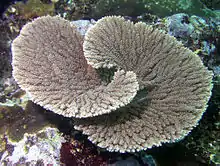| Acropora clathrata | |
|---|---|
 | |
| Scientific classification | |
| Domain: | Eukaryota |
| Kingdom: | Animalia |
| Phylum: | Cnidaria |
| Class: | Hexacorallia |
| Order: | Scleractinia |
| Family: | Acroporidae |
| Genus: | Acropora |
| Species: | A. clathrata |
| Binomial name | |
| Acropora clathrata (Brook, 1891) | |
Acropora clathrata, commonly known as lattice table coral is a species of stony corals belonging to the family Acroporidae.[2] They are a zooxanthellate coral, which are generally found in fringing reefs, sheltered reefs and back reef habitats, between the depths of 5–40 m (16–131 ft).[3][4] Its size varies according to the depth at which they are found, with members of the species that have larger surface areas typically found at greater depths.[5]
The species is native to Indo-Central Pacific region where it is widespread from Madagascar to the Red Sea to Western Australia.[2]
Ecology
The species is an important resource for Spirobranchus giganteus, which is found embedded in Acropora chlathrata in much higher densities than other stony corals.[5] Oil-degrading bacteria affiliated with Gammaproteobacteria, Actinobacteria and Firmicutes harbored in the tissue of Acropora clathrata aid the survival of the species as oil concentrations in their environment change.[6]
Conservation
Life Cycle
Acropora eggs go through five changes in color as they develop. The first of these stages is white, followed by light-cream, cream, light-pink, and, finally, pink when mature.[7]
References
- ↑ Richards, Z.; Delbeek, J.C.; Lovell, E.; Bass, D.; Aeby, G.; Reboton, C. (2008). "Acropora clathrata". IUCN Red List of Threatened Species. 2008: e.T133207A3631022. doi:10.2305/IUCN.UK.2008.RLTS.T133207A3631022.en. Retrieved 11 November 2022.
- 1 2 3 "Acropora clathrata (Brook, 1891)". www.gbif.org. Retrieved 18 October 2021.
- ↑ "Acropora clathrata". Corals of the World. Retrieved 18 October 2021.
- ↑ "Acropora clathrata". WA Museum. 14 February 2017. Retrieved 18 October 2021.
- 1 2 Floros, C.D.; Samways, M.J.; Armstrong, B. (May 2005). "Polychaete (Spirobranchus giganteus) loading on South African corals". Aquatic Conservation: Marine and Freshwater Ecosystems. 15 (3): 289–298. doi:10.1002/aqc.666. ISSN 1052-7613.
- ↑ Al-Dahash, Lulwa M.; Mahmoud, Huda M. (2013-07-30). "Harboring oil-degrading bacteria: A potential mechanism of adaptation and survival in corals inhabiting oil-contaminated reefs". Marine Pollution Bulletin. Coral reefs of the Gulf: Past, present and the future of a unique ecosystem. 72 (2): 364–374. doi:10.1016/j.marpolbul.2012.08.029. ISSN 0025-326X.
- ↑ M. Ibrahim, Remon; et al. (2021-03-01). "Gametogenic development and synchronous spawning of the acroporid corals Acropora cytherea and Acropora tenuis in the Red Sea". Egyptian Journal of Aquatic Biology and Fisheries. 25 (2): 419–436. doi:10.21608/ejabf.2021.164595. ISSN 2536-9814.
